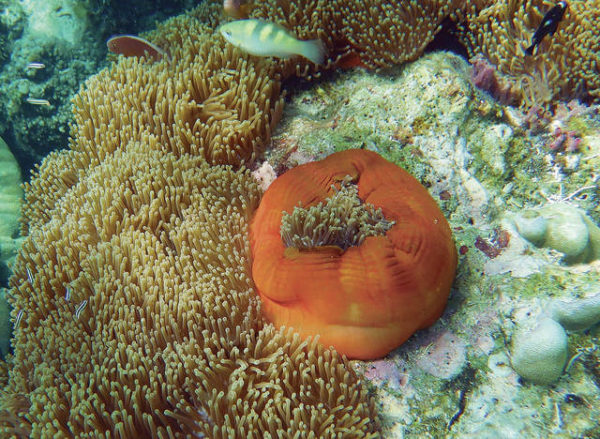Published in the Ocean Watch column, Honolulu Star-Advertiser © Susan Scott
March 9, 2019
I’m home from an African vacation that included two weeks of safari tours in several of Tanzania’s national parks. When friends suggested we end the trip with a visit to Zanzibar, about 25 miles offshore of Tanzania, I agreed. Freddie Mercury was born there, reason enough for this Queen fan to go. In addition, the Zanzibar archipelago lies in the equatorial waters of the Indian Ocean.
The snorkeling, I figured, would be superb.
We stayed at a resort in a remote part of the main island and snorkeled from a dhow, the region’s traditional lateen-rigged boat. Sailing in a dhow would have been thrilling enough, but then I jumped over the side and put my face in the water.
Never have I seen so many sea anemones, most 1 to 3 feet across. These graceful soft-coral relatives swayed in clumps, rows and circles, filling peaks and valleys of reef as far as I could see. Often the current raised the anemones’ fringed skirts, revealing glimpses of their pink, purple or orange bases.
 When a sea anemone is threatened,
When a sea anemone is threatened,
it contracts its pedestal over most of its tentacles.
©2019 Susan Scott
A single anemone consists of a cluster of tentacles attached to the ocean floor. Some sea anemones anchor themselves in sand or mud, but those I saw were using their bases, called pedestals, to hang onto rocks.
At the center of each pedestal is a round mouth surrounded by tentacles. You can’t often see the mouth for all the waving going on in the ocean currents, but it’s there, swallowing any meat its tentacles can deliver.
Sea anemones were likely, and aptly, named after the European wood anemone, a flower that causes skin blisters. These animals may be floral pretty, but they’re predators, their swaying tentacles bearing stinging cells similar to those of jellyfish. As with various species of jellyfish, some anemone stings are so mild they don’t penetrate human skin, and some are so strong that a mere brush against one can cause angry, weeping blisters.
With so many anemones in this area of balmy Indian Ocean waters (we guessed the water was about 90 degrees), I wasn’t surprised to see several kinds of anemone fish. It was the first time, however, I had seen them out and about. Usually these small damselfish, immune to the anemone’s sting, duck and hide inside the tentacles’ protection upon the approach of a snorkeler or diver. Apparently, with nearly endless shelters available, the fish could afford to be more cavalier.
Hawaii hosts only a few kinds of sea anemones, all small and difficult to find. South Pacific waters host larger and more abundant species but nothing like what I found off Zanzibar.
My guess that the snorkeling there would be superb was correct, as was my much-anticipated thrill over visiting Freddie Mercury’s birthplace. Zanzibar rocked me.